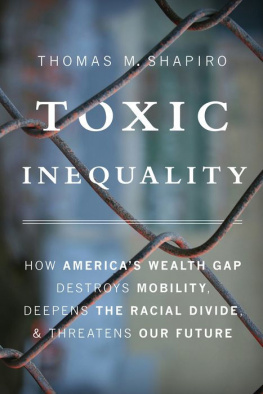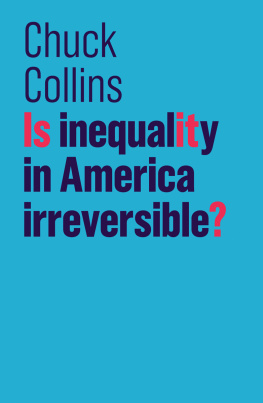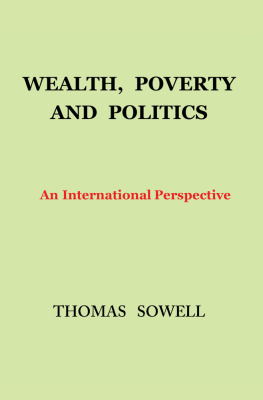Thomas M. Shapiro - Toxic Inequality: How America’s Wealth Gap Destroys Mobility, Deepens the Racial Divide, and Threatens Our Future
Here you can read online Thomas M. Shapiro - Toxic Inequality: How America’s Wealth Gap Destroys Mobility, Deepens the Racial Divide, and Threatens Our Future full text of the book (entire story) in english for free. Download pdf and epub, get meaning, cover and reviews about this ebook. year: 2017, publisher: Basic Books, genre: Home and family. Description of the work, (preface) as well as reviews are available. Best literature library LitArk.com created for fans of good reading and offers a wide selection of genres:
Romance novel
Science fiction
Adventure
Detective
Science
History
Home and family
Prose
Art
Politics
Computer
Non-fiction
Religion
Business
Children
Humor
Choose a favorite category and find really read worthwhile books. Enjoy immersion in the world of imagination, feel the emotions of the characters or learn something new for yourself, make an fascinating discovery.
- Book:Toxic Inequality: How America’s Wealth Gap Destroys Mobility, Deepens the Racial Divide, and Threatens Our Future
- Author:
- Publisher:Basic Books
- Genre:
- Year:2017
- Rating:5 / 5
- Favourites:Add to favourites
- Your mark:
- 100
- 1
- 2
- 3
- 4
- 5
Toxic Inequality: How America’s Wealth Gap Destroys Mobility, Deepens the Racial Divide, and Threatens Our Future: summary, description and annotation
We offer to read an annotation, description, summary or preface (depends on what the author of the book "Toxic Inequality: How America’s Wealth Gap Destroys Mobility, Deepens the Racial Divide, and Threatens Our Future" wrote himself). If you haven't found the necessary information about the book — write in the comments, we will try to find it.
Thomas M. Shapiro: author's other books
Who wrote Toxic Inequality: How America’s Wealth Gap Destroys Mobility, Deepens the Racial Divide, and Threatens Our Future? Find out the surname, the name of the author of the book and a list of all author's works by series.
Toxic Inequality: How America’s Wealth Gap Destroys Mobility, Deepens the Racial Divide, and Threatens Our Future — read online for free the complete book (whole text) full work
Below is the text of the book, divided by pages. System saving the place of the last page read, allows you to conveniently read the book "Toxic Inequality: How America’s Wealth Gap Destroys Mobility, Deepens the Racial Divide, and Threatens Our Future" online for free, without having to search again every time where you left off. Put a bookmark, and you can go to the page where you finished reading at any time.
Font size:
Interval:
Bookmark:

Copyright 2017 by Thomas M. Shapiro.
Published in the United States by Basic Books, an imprint of Perseus Books, LLC, a subsidiary of Hachette Book Group, Inc.
All rights reserved. Printed in the United States of America. No part of this book may be reproduced in any manner whatsoever without written permission except in the case of brief quotations embodied in critical articles and reviews. For information, address Basic Books, 1290 Avenue of the Americas, New York, NY 10104.
Books published by Basic Books are available at special discounts for bulk purchases in the United States by corporations, institutions, and other organizations. For more information, please contact the Special Markets Department at Perseus Books, 2300 Chestnut Street, Suite 200, Philadelphia, PA 19103, or call (800) 810-4145, ext. 5000, or e-mail special.markets@perseusbooks.com.
Designed by Linda Mark
Library of Congress Cataloging-in-Publication Data
Names: Shapiro, Thomas M., author.
Title: Toxic inequality : the true costs of poverty and racial injustice for Americas families / Thomas M. Shapiro.
Description: New York : Basic Books, [2017] | Includes bibliographical references and index.
Identifiers: LCCN 2016043570 (print) | LCCN 2016058087 (e-book) | ISBN 9780465046935 (hardcover : alk. paper) | ISBN 9780465094875 (e-book)
Subjects: LCSH: PovertyUnited States. | Income distributionUnited States. | EqualityUnited States. | RacismUnited States. | United StatesEconomic conditions21st century. | United StatesSocial conditions21st century.
Classification: LCC HC110.P6 S43 2017 (print) | LCC HC110.P6 (ebook) | DDC 339.4/60973dc23
LC record available at https://lccn.loc.gov/2016043570
E3-20170210-JV-NF
For Ruth and Izak,
The wealth of my life
P ATRICIA A RRORAS STORY COULD HAVE TAKEN MANY TURNS.
The daughter of a single mom who worked as a maid until she became disabled, Patricia grew up in the crime- and drug-plagued neighborhood of Watts, in South Central Los Angeles. At an early age, she became a single mother herself and began collecting welfare benefits. But although Wattss troubles defined Patricias early years, a desire to move up and away from her hometowns illsits bad reputation, its gangs, and its drugsmotivated her subsequent lifes journey. Despite challenges and detours along the way, she has secured many of her dreams. But her path was harder than it had to be. For African American single moms like her, and for many other Americans, barriers to prosperity are too high to overcome through individual achievement, and success is rarer than it should be.
My colleagues and I first met Patricia in 1998, when she was forty-six years old. Hers was one of 187 families across the United States that we interviewed in hopes of learning how differing wealth resources shape the plans, opportunities, and futures of individuals from different walks of life. We wanted to understand how people chose schools for their children, decided where to live to best accommodate their familys needs, and planned to achieve economic mobility. We were also eager to learn about the different pathways that lower-income families and families of color must take as they strive for better lives.
We recruited families from child-care centers and through word of mouth in Boston, Los Angeles, and St. Louis. By design, about half of the families we interviewed were white, and half were African American; half were middle-class or better-off, and half were working-class or poor; half resided in the three cities themselves, and half lived in suburbs of those same metropolitan areas. From the interviews we conducted in the late 1990s, we gleaned invaluable insights into the hopes, dreams, and difficulties of a wide swath of American families.
Between 1998 and 2010, when we conducted our first follow-up interviews, the Great Recession and implosion of the US housing market hit hard. Beginning in late 2007 and officially ending in mid-2009, this crisis profoundly impacted families nationwide. In the wake of the recession, between 2010 and 2012, the team contacted and interviewed 137 of the 187 families interviewed twelve years before. Technically speaking, the recession was over, but our conversations revealed that the crisis was clearly still unfolding. Most of the families we talked with were reeling from job losses, adjusting to reduced incomes, or having trouble making mortgage payments. One adult in fifty-three of the families had lost his or her job during the recession; fifty families experienced lower incomes at some point during the recession; and at least a dozen had fallen behind on their mortgages. Seven families lost their homes due to foreclosure.
By 2012, those who had been children when we conducted our first set of interviews were now young adults finishing high school, planning for college, entering the workforce, or starting families of their own. The parents we spoke to in 1998 were now in a position to tell us how their plans had worked out and how their resources had affected their own mobility and that of their children. With these two sets of interviews in hand, we traced the divergent advantages and challenges associated with race and economic status that confront families striving to move ahead in the United States. The interviews underlined how we must understand economic and racial inequality in tandem, how vast wealth disparities and racial injustice do real harm to individual families, and how powerful institutional forces, rather than individual choices, distinguish those families who get ahead from those stuck in place or falling behind. The story of Patricia and her family illustrates many of these themes and exemplifies the political and economic structures that at times helped launch her economic mobility and at others destroyed her wealth.
When we first talked to Patricia Arrora at her apartment in 1998, she had just moved herself off of social assistance. She and 13 million other people had been receiving cash assistance when the program known as Aid to Families with Dependent Children (AFDC) ended in 1996. Subsequent economic growth pulled her and others from welfare into paying jobs and by 2000 had, along with new rules restricting eligibility for social assistance, halved the rolls in the program that replaced AFDC, Temporary Assistance for Needy Families. When we spoke Patricia had taken a job processing applications for a local utility company in Los Angeles County, and the probationary salary put her familys income just below the federal governments official poverty threshold. This threshold is the minimum level of income deemed adequate to feed, clothe, and house a family; it is calibrated by family size. The calculation is based on this standard, as is eligibility for some government programs. For Patricias family of three in 1998 the poverty line was $13,650. Patricia wistfully told us that she was looking to meet a millionaire to rescue her. Still, if she succeeded past the probationary period and secured a permanent position, the annual pay of $19,800 (in 1998 dollars) would nudge Patricia and her four- and five-year-old daughters just above the poverty line. A job paying less than $20,000 a year may not sound like much, and Patricia had no financial wealth: no savings, stocks, bonds, property, or car, and certainly no pension or other retirement plan. But for Patricia, the job represented a huge and proud step up.
Sitting in her apartment in 1998, Patricia told us how she had taken classes to learn computer skills, gaining experience that paved the road away from AFDC and helped her secure employment. Having a job and knowing that tomorrow would bring a stable, earned paycheck was crucial to Patricias identity and dignity. Although eager to bring home more than the $700 monthly welfare payments she had been receiving, she also longed for the sense of self-esteem that came with work. Some critics view poor people as suffering from character defects, such as a lack of ambition or work ethic, welfare dependence, or an inability to defer gratification. Patricia didnt actually have these traits.
Font size:
Interval:
Bookmark:
Similar books «Toxic Inequality: How America’s Wealth Gap Destroys Mobility, Deepens the Racial Divide, and Threatens Our Future»
Look at similar books to Toxic Inequality: How America’s Wealth Gap Destroys Mobility, Deepens the Racial Divide, and Threatens Our Future. We have selected literature similar in name and meaning in the hope of providing readers with more options to find new, interesting, not yet read works.
Discussion, reviews of the book Toxic Inequality: How America’s Wealth Gap Destroys Mobility, Deepens the Racial Divide, and Threatens Our Future and just readers' own opinions. Leave your comments, write what you think about the work, its meaning or the main characters. Specify what exactly you liked and what you didn't like, and why you think so.





